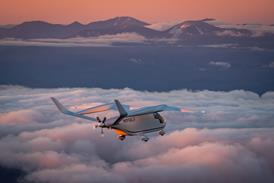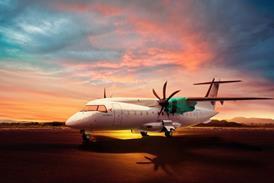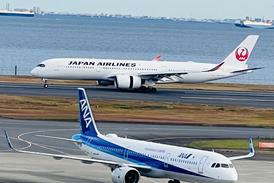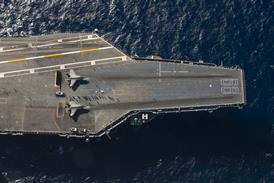By Brendan Sobie in London
Patee Sarasin is proud to explain how he “has broken every rule” in launching and running Nok Air, a Thai low-cost carrier that has quickly become profitable and is planning to expand well beyond its current five-aircraft fleet.
 Patee has used his advertising background to come up with a steady stream of innovations for the low-cost carrier market. The carrier sells tickets through cash machines, mobile phone networks, convenience stores and movie rental shops. Before launching in 2004, Nok picked its first batch of flight attendants through a competitive reality TV series. It has since selected new flight attendants by holding “activities” or parties sponsored by local banks and Coca Cola. Passengers can receive messages from Nok on their mobile phone to inform them which flights their favourite flight attendants are flying.
Patee has used his advertising background to come up with a steady stream of innovations for the low-cost carrier market. The carrier sells tickets through cash machines, mobile phone networks, convenience stores and movie rental shops. Before launching in 2004, Nok picked its first batch of flight attendants through a competitive reality TV series. It has since selected new flight attendants by holding “activities” or parties sponsored by local banks and Coca Cola. Passengers can receive messages from Nok on their mobile phone to inform them which flights their favourite flight attendants are flying.
“The most important thing about Nok Air is we are having a lot of fun,” Patee says, adding his strategy is focused on having a strong brand and distribution network. At Nok, he says LCC does not stand for low-cost carrier but “lovable, charming and cuddly”.
In April Nok launched a video “Let’s go to the sea”, which is being played on MTV and local radio stations, featuring Patee rapping. Also earlier this year Nok began hiring “girls” at all its airport to hold personal digit assistants (PDAs) that are used to help check in passengers that only have carry-on bags.
“It’s been fantastically well received,” Patee says, adding 15-20% of its passengers now use the PDA-based “Nok X” service. In congested Bangkok it is most popular because it helps reduce queues.
“It is very efficient and costs you less than £2 ($3.75) a day to have these girls walking around in Thailand,” he says.
Passengers can also use Nok’s telephone check-in service. In downtown Bangkok check-in is available at its Nok Air Shop and in Phuket at a beachside hotel. Nok also has three self-service check-in kiosks at Bangkok’s Don Muang Airport and will have seven when it moves to Bangkok’s new Suvarnabhumi airport on 27 September. But he points out with a PDA “you don’t need start-up costs of $40,000”.
Rocking the world
Patee’s next innovation is Nok’s frequent-flyer programme, which will be launched in four to six months. “We’re working on one that is outrageous,” he says but declining to provide any details. “We’ll rock the whole world.”
He says Nok’s board sees Patee’s strategy as “fresh” and is generally supportive. But he admits some of his ideas don’t make it to the board because they are rejected by his chief operating officer and other executives who have airline experience, mainly from Thai Airways International, which owns 39% of Nok.
“I don’t work alone,” Patee says. “I work with a group of people who are airline executives. So there are limitations about working out of the box.”
While Nok leased its first five aircraft from Thai Airways and the two are now experimenting with a codeshare on the Bangkok-Chiang Mai route, the two operate completely independently and have different boards. Patee points out that some of its additional aircraft will be leased from other sources and it will begin using Air France to provide some maintenance services, which until now have only been provided by Thai. Patee points out that Thai absorbs all the costs of the codeshare, including transferring bags, and there will be no links between their two frequent-flier programmes.
Besides Thai Airways, Nok is owned by a group of eight other Thai companies or investment firms and several individuals. While Thai has seen its profit fall dramatically over the past two years, Nok posted an operating profit in its first year and from a net standpoint broke even in the first half of 2006. The positive operating results were partly driven by ancillary revenues, including from selling advertising on board the aircraft and from selling tickets to space as part of a marketing deal with Space Adventures.
Going international
Hardly anyone outside Thailand has heard of Nok because it now only operates domestically and 70% of its passengers are Thai. But Nok’s notoriety outside Thailand is about to change. In January, it plans to launch its first international service, to Bangalore in India, in partnership with low-fare carrier Air Deccan.
Services to Chennai and Hyderabad, also in India, are planned for later in 2007.
Patee has been looking at India, China and other international markets since shortly after launching in 2004 and initially planned to begin international services in early 2005.
“Our strategy has changed over time,” he says “It’s better to own our own country rather than move out with the rest of the gang.
“Before going to India we really need to work on a marketing solution. It will be an investment and this investment needs to pay off. We don’t want to rush. India is a totally a different type of market from Thailand in the way it works. We need to understand the Indians. We can’t make a mistake once we land there.”
Nok has carried over two million passengers since launching in July 2004 and has already captured about a 20% share of the domestic market. But the Thai domestic market is near saturation and Patee envisions Nok and Thailand’s two other low-cost carriers, One-Two Go and Thai AirAsia, having roughly equal market shares. After it launches services to its 10th and 11th Thai cities in October, Patee says there are only one or two more domestic destinations to add. Patee envisions Nok picking up some traffic from Thai Airways as the flag carrier drops more domestic routes but he says overall growth will be steady and not explosive because a lot of Thais are scared of flying, do not have the income to fly or still prefer to take the bus.
“After seven aircraft Thailand will be saturated from our point of view. Then we’ll be moving internationally,” he explains.
Nok now flies four 737-400s and one ATR 72 13 hours per day. In October it will add two 737-400s, giving it a seven-aircraft schedule, and take a second ATR 72 which will be used as a spare. For next year Nok is looking at taking on several additional 737-400s to support its new international services, including 737-400s Thai may offload as it reduces its own domestic services and some of the 14 737-400s Malaysia Airlines is looking to lease out because it is handing most of its domestic routes to AirAsia.
Patee made a drastic career change in 2004 to join Nok from Bates Advertising Thailand, where he was chief executive. But he does not plan to return to the advertising industry, where he started as research manager prior to earning a masters degree in mass communication film and video from American University in Washington DC and quickly rose through the ranks to creative director.
“I’ll keep doing it [running Nok] until I’m bored of it,” says the 43-year-old. “I have to put myself as an airline guy now who puts my advertising experience into full use.”

Click here for more Airline Business interviews
Source: Airline Business























